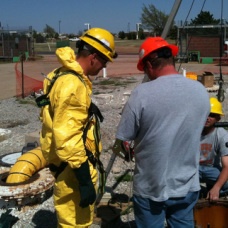Establishing a Personal Protective Equipment (PPE) plan is one of the most basic functions of an effective workplace safety program. It is also the last line of defense for employee safety. PPE shouldn’t be used unless there is no other way to protect the employee from hazards related to the job through engineering or guarding. A comprehensive PPE plan starts with a job safety analysis (JSA) for each drilling project.
Environmental drilling offers unique challenges for a workplace safety program because the type of drilling performed, the site terrain and geology, and known or potential environmental hazards that may vary significantly from project to project. The JSA identifies the equipment to be used, the tasks to be performed and any specific chemical or other hazards to which workers may be exposed at each specific job site. Job-specific PPE requirements ensure the highest level of worker safety, which minimizes injuries and helps to keep your project on schedule.
What are the Physical Hazards of Drilling?
Drilling projects pose a number of physical hazards, the most common of which are falling or flying objects. Individual PPE provides protection from falling and flying objects. A JSA ensures a comprehensive evaluation of job-specific PPE requirements for each body part.
Head Protection - A hard hat is the number one piece of safety equipment. They are worn on all drilling sites and areas where work might be performed under heavy objects, or where there is the possibility of injury from falling objects.
Foot Protection – Safety shoes or boots are worn by all drilling personnel and those within close proximity to the drill rig.
Hand Protection – Gloves are worn by all drilling personal to protect against cuts and abrasion that can occur when handling wire rope or cable and from contact with sharp edges and burrs on drill rods and other drilling or sampling tools. Gloves are worn when work activities involve handling the drilling equipment, sampling devices or even when servicing the drill unit.
Eye Protection – Safety glasses meeting ANSI requirements are worn by all personnel operating or using any equipment.
Hearing Protection – Ear plugs meeting ANSI standards are worn when noise exposure is 85 dBA or greater.
Are there any other hazards with Environmental Drilling?
Falls – Work done above 3 feet on the mast requires the use of a safety harness or lowering of the mast. When it is necessary to work at heights greater than 6 feet, PPE recommendations include guardrails and or a personal fall arrest system.
Is There Other PPE?
For some drilling operations, the environment or current regulations may dictate the use of other PPE. Such equipment might include a face shield, respirator, or tyvek. When drilling is performed in a chemically or radiological contaminated environment, special protective equipment may be required.
Effective worker safety practices are at the heart of injury and loss prevention and timely completion of your drilling project. At Talon/LPE, our drillers are trained by in-house health and safety staff to make certain that your drilling projects are performed in a safe and environmentally conscious manner. That translates to safety for our employees and peace of mind for you. Contact us today for your next environmental drilling project in Texas.

